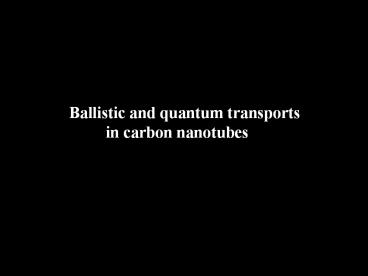Ballistic and quantum transports PowerPoint PPT Presentation
Title: Ballistic and quantum transports
1
Ballistic and quantum transports in
carbon nanotubes
2
Discrete energy levels in carbon nanotubes
3
Two atoms two energy levels
4
Three atoms three energy levels
5
atoms
6
(No Transcript)
7
Metallic (no band gap)
Semiconductor Small band gap (0.1-3eV)
Insulator (large band gap gt 5 eV)
8
Spacing between levels becomes too small to be
distinguished So it can be regarded as a band
structure
Fermi sea
CB
Free-e-
Free-e-
EF
VB
Ve-
N infinite (metals)
As long as kinetic energy is sufficient free
electron movement can change from lane to lane
9
a. Underlying mechanism for ballistic transport
Bulk Cu
CB
EF
EF
VB
Corresponding band structure
Conduction electron paths in all directions
within CB
Discrete levels
?
Spacing increase
Nanowire (quantum wire)
EF
Nanodot (quantum dot)
Sub-bands
10
M
temp
EF
Band gap
11
(No Transcript)
12
(No Transcript)
13
(No Transcript)
14
(No Transcript)
15
Science, 283, 52 (1999).
16
Quantum transport in carbon nanotubes
17
- Metallic CNTs have two conduction bands (two
conduction channels). - one conduction channel of quantum unit Go
12.9 (K?)-1 2e2/h. - Two conduction channels 2Go 4e2/h 6.5 (K?)-1
If contact resistance is small and
negligible then CNT resistance between contacts
Should be 6.5K?
18
- In practice, resistance exceeds 6.5 k? and
underlying - Mechanism comes from
- Semiconducting tubes
- Huge contact resistance
- Defects in metallic CNTs
19
High contact resistance
Electrons are unable to enter into CNT (joule
heating)
20
Electric charges induce voltage at leads but no
current flow in CNT
(coulomb oscillation)
-
CNT
Thick contact barrier
Existing electrons in CNTs exclude incoming
electrons
Coulomb blockage
tunneling
CNT
Thin contact barrier
Existing conduction electrons in CNT
21
Gate voltage
Gate voltage electric field modulated chemical
potential (energy levels)
22
gate
gate
Two electrons occupying one level
Modulation of energy levels by gate voltage
23
Go
24
Ballistic transport in carbon nanotubes Electron
conduction has no resistance and no heat
generation and structures are defect-free.
25
Transport delay by resistance
e-
e-
26
Resistance comes from thermal vibration of
crystal lattice, electrons and impurities
Resistance point (scattering)
e-
mean free path no resistance
Cu (mean free path) 1 ?m
27
Size reduction to below 1 ?m in length
free path with no resistance
e-
28
electrodes
backscattering
e-
Nanowire on electrodes
resistance at wire-electrode contact
29
(No Transcript)
30
Fabry-Perot interference
31
When defects exist the ballistic transport is
absent
Fabry-perot interference
defect
No Fabry-perot interference
32
Defects in CNTs
Scattering center
EF
Blocking of two conduction channels ?????????
33
Mean free path in Cu is 1 ?m
Scattering centers
1?m
Mean free path is ca. 100-300 nm in CNT
34
Conditions for ballistic transport
a. Tube length ? electron mean free paths (or no
defects)
b. Low contact resistance (low capacitance)
dielectric
leads
-
CNT
High contact resistance (capacitor-like)
capacitor
c. Gate voltage is not needed (different from
that of quantum wire)
High contact resistance (tunneling)
Low contact resistance
gate
35
Science, 280, 1744
36
(No Transcript)
37
R
A general case
Distance
A
B
C
A
B
C
-
-
-
R
R
R
38
Ballistic transport effects
- No heat generation, because no electron-phonon
interaction - (i.e. no scattering by defects)
b. Stepwise I-V profile (or quantum conduction)
39
Conduction via individual atoms
a. Nano-contact
40
b. electro-sharpening of metal wire
Quantum conduction
Diffusive conduction
41
c. Mechanical break junction
42
??
Single atom
??
How to transmit through a single atom
Conduction through individual orbits
43
3
6
5
44
Ohmic conductor (linear I-V profile)
Current
metals
Voltage
45
Non-linear I-V profile (non-ohmic conductor)
current
Light bulb
voltage
46
semiconductors
current
voltage
47
Theory of coulomb blockage
http//edu.ioffe.ru/register/?docgalperin/l13pdf1
.tex
If one transfers the charge Q from the source to
the grain the change in the energy of the system
is
48
the effective capacitance C
the gate voltage VG
the first item is the work by the source of the
gate voltage while the second is the energy of
Coulomb repulsion at the grain.
-
Polarization of leads
e-
Q CVG
So Q can be tuned by the gate voltage VG
49
the charge is transferred by the electrons with
the charge e. Then, the energy as a function
of the number n of electrons at the drain is
the difference
at certain values of VG,
and the difference vanishes.
It means that only at that values of the gate
voltage resonant transfer is possible.

